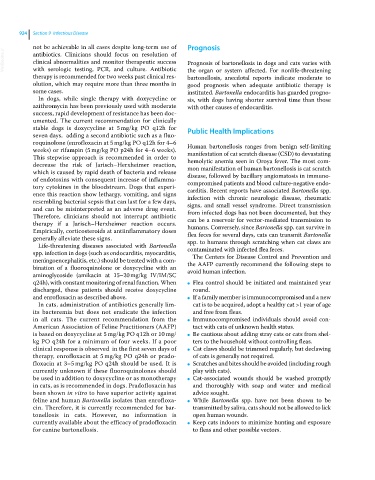Page 986 - Clinical Small Animal Internal Medicine
P. 986
924 Section 9 Infectious Disease
not be achievable in all cases despite long‐term use of Prognosis
VetBooks.ir antibiotics. Clinicians should focus on resolution of Prognosis of bartonellosis in dogs and cats varies with
clinical abnormalities and monitor therapeutic success
with serologic testing, PCR, and culture. Antibiotic
therapy is recommended for two weeks past clinical res- the organ or system affected. For nonlife‐threatening
bartonellosis, anecdotal reports indicate moderate to
olution, which may require more than three months in good prognosis when adequate antibiotic therapy is
some cases. instituted. Bartonella endocarditis has guarded progno-
In dogs, while single therapy with doxycycline or sis, with dogs having shorter survival time than those
azithromycin has been previously used with moderate with other causes of endocarditis.
success, rapid development of resistance has been doc-
umented. The current recommendation for clinically
stable dogs is doxycycline at 5 mg/kg PO q12h for Public Health Implications
seven days, adding a second antibiotic such as a fluo-
roquinolone (enrofloxacin at 5 mg/kg PO q12h for 4–6 Human bartonellosis ranges from benign self‐limiting
weeks) or rifampin (5 mg/kg PO p24h for 4–6 weeks). manifestation of cat scratch disease (CSD) to devastating
This stepwise approach is recommended in order to hemolytic anemia seen in Oroya fever. The most com-
decrease the risk of Jarisch–Herxheimer reaction, mon manifestation of human bartonellosis is cat scratch
which is caused by rapid death of bacteria and release disease, followed by bacillary angiomatosis in immuno-
of endotoxins with consequent increase of inflamma- compromised patients and blood culture‐negative endo-
tory cytokines in the bloodstream. Dogs that experi- carditis. Recent reports have associated Bartonella spp.
ence this reaction show lethargy, vomiting, and signs infection with chronic neurologic disease, rheumatic
resembling bacterial sepsis that can last for a few days, signs, and small vessel syndrome. Direct transmission
and can be misinterpreted as an adverse drug event. from infected dogs has not been documented, but they
Therefore, clinicians should not interrupt antibiotic can be a reservoir for vector‐mediated transmission to
therapy if a Jarisch–Herxheimer reaction occurs. humans. Conversely, since Bartonella spp. can survive in
Empirically, corticosteroids at antiinflammatory doses flea feces for several days, cats can transmit Bartonella
generally alleviate these signs. spp. to humans through scratching when cat claws are
Life‐threatening diseases associated with Bartonella
spp. infection in dogs (such as endocarditis, myocarditis, contaminated with infected flea feces.
The Centers for Disease Control and Prevention and
meningoencephalitis, etc.) should be treated with a com- the AAFP currently recommend the following steps to
bination of a fluoroquinolone or doxycycline with an avoid human infection.
aminoglycoside (amikacin at 15–20 mg/kg IV/IM/SC
q24h), with constant monitoring of renal function. When ● Flea control should be initiated and maintained year
discharged, these patients should receive doxycycline round.
and enrofloxacin as described above. ● If a family member is immunocompromised and a new
In cats, administration of antibiotics generally lim- cat is to be acquired, adopt a healthy cat >1 year of age
its bacteremia but does not eradicate the infection and free from fleas.
in all cats. The current recommendation from the ● Immunocompromised individuals should avoid con-
American Association of Feline Practitioners (AAFP) tact with cats of unknown health status.
is based on doxycycline at 5 mg/kg PO q12h or 10 mg/ ● Be cautious about adding stray cats or cats from shel-
kg PO q24h for a minimum of four weeks. If a poor ters to the household without controlling fleas.
clinical response is observed in the first seven days of ● Cat claws should be trimmed regularly, but declawing
therapy, enrofloxacin at 5 mg/kg PO q24h or prado- of cats is generally not required.
floxacin at 3–5 mg/kg PO q24h should be used. It is ● Scratches and bites should be avoided (including rough
currently unknown if these fluoroquinolones should play with cats).
be used in addition to doxycycline or as monotherapy ● Cat‐associated wounds should be washed promptly
in cats, as is recommended in dogs. Pradofloxacin has and thoroughly with soap and water and medical
been shown in vitro to have superior activity against advice sought.
feline and human Bartonella isolates than enrofloxa- ● While Bartonella spp. have not been shown to be
cin. Therefore, it is currently recommended for bar- transmitted by saliva, cats should not be allowed to lick
tonellosis in cats. However, no information is open human wounds.
currently available about the efficacy of pradofloxacin ● Keep cats indoors to minimize hunting and exposure
for canine bartonellosis. to fleas and other possible vectors.

